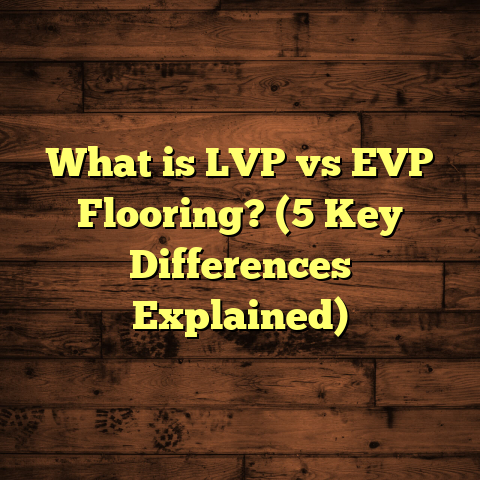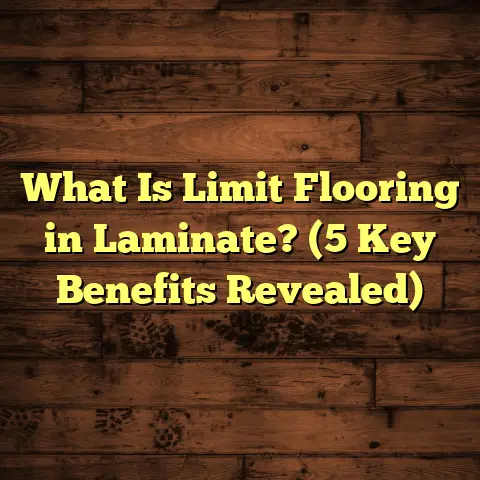What is a Manufactured Wood Floor? (5 Benefits You Didn’t Know)
“Manufactured wood flooring combines the beauty of natural wood
with enhanced stability and ease of installation. It’s a smart choice
for many homeowners.” — Mark Johnson, flooring expert with 20+ years of experience
What is a Manufactured Wood Floor?
I get asked this question more often than you might think:
What exactly is a manufactured wood floor? Well, it’s a clever kind of flooring that blends real wood’s natural charm with modern construction techniques to solve some of the problems solid hardwood floors can face.
Manufactured wood floors are built from layers. The topmost layer is a thin slice of genuine hardwood—oak, maple, walnut, or whatever species you prefer. That layer gives you the authentic wood grain and texture underfoot. Beneath that, there are multiple layers of plywood or high-density fiberboard (HDF), arranged so that the grain runs perpendicular to the layer above or below it.
Why does this matter? Because this cross-layering technique stabilizes the plank. It reduces the natural expansion and contraction caused by temperature and humidity changes. This means your floor stays flat, smooth, and beautiful longer than solid wood that’s just one thick piece.
I’ve installed hundreds of these floors over the years and noticed something right away: manufactured wood is much more forgiving in tricky environments like basements, kitchens, and even in coastal homes where moisture is a constant battle. For example, I worked on a beach house renovation near Charleston once. The client wanted hardwood floors but worried about warping due to humidity. Manufactured wood was a perfect fit — it held up for years without any issues.
How Manufactured Wood Flooring is Made: A Closer Look
Let me take you inside the process because it’s pretty fascinating and explains why this type of flooring works so well.
- The Veneer Layer
This is the hardwood surface you see. It’s cut thin—usually between 0.6mm to 6mm thick—depending on quality and price point. The thinner the veneer, the fewer times it can be sanded and refinished later. - Core Layers
Beneath the veneer are several layers of plywood or HDF. The key is their grain orientation: each layer’s grain runs at right angles to the one above or below. This cross-ply construction minimizes movement caused by moisture changes—a common culprit behind warped floors. - Backing Layer
Finally, there’s a bottom layer designed to add stability and balance out any stress from above layers.
The result? A plank that behaves very differently from solid wood but looks just as stunning.
My Personal Experience Installing Manufactured Wood Floors
Years ago, I was hired for a large project in a suburban home with an open concept living room and kitchen. The homeowners wanted hardwood floors throughout but had concerns about moisture near the kitchen sink and occasional spills.
We chose a manufactured wood floor with a 4mm wear layer on top of a plywood core. Installation was surprisingly swift — we floated the floor over an existing concrete slab with a moisture barrier beneath.
After two years, I returned for routine maintenance advice and was thrilled to see the floors still looked flawless — no gaps or cupping, just that warm glow of real wood.
This project made me realize how versatile these floors are—and how they suit not just traditional homes but also modern-day lifestyles where durability matters as much as style.
5 Benefits You Didn’t Know About Manufactured Wood Floors
You may already know some benefits like easier installation or cost savings. But here are five perks that surprised even me when I first learned about them:
1. Superior Stability in Challenging Environments
Have you ever heard horror stories about solid wood floors buckling or warping when humidity spikes? I’ve seen it happen more times than I can count.
Thanks to its layered design, manufactured wood resists these changes much better. The perpendicular grain alignment in the core layers counteracts expansion forces.
According to data from the National Wood Flooring Association (NWFA), engineered floors can withstand relative humidity changes up to 40% better than solid hardwood without damage.
This stability makes manufactured wood ideal for basements, kitchens, bathrooms, or even sunrooms—places where solid wood might fail.
2. Installation Speed and Flexibility
One project sticks in my mind: a couple needed new floors before a family reunion in three days—no pressure! Solid hardwood wasn’t an option given time constraints.
We installed engineered wood planks using a floating floor method over their existing tile. The click-lock system meant no nails or glue were required.
The job took just two days, leaving plenty of time for finishing touches.
This ease and speed come from the various installation methods possible with manufactured wood:
- Floating (click-lock)
- Glue-down
- Nail-down
Each suits different subfloor types and homeowner needs.
3. Cost Savings Without Compromising Look
Flooring costs can spiral quickly when aiming for solid hardwood across large areas.
Manufactured wood allows you to save money while still enjoying real wood surfaces.
I typically see prices between $5–$10 per sq ft installed for good-quality manufactured products versus $8–$15+ per sq ft for solid hardwood.
These savings add up fast on big jobs and make luxury flooring accessible to more people.
Even better: many manufacturers offer stunning finishes and exotic species on engineered planks, so you don’t have to sacrifice style for budget.
4. Eco-Friendly Flooring Choice
If you care about sustainability as much as I do, you’ll appreciate that manufactured wood uses less high-quality hardwood overall.
Only the top veneer layer is precious wood; the core uses faster-growing or recycled woods like birch or poplar plywood.
Organizations like the Forest Stewardship Council (FSC) certify many engineered woods sourced from responsibly managed forests.
Choosing manufactured wood means less waste during production and reduced pressure on old-growth forests.
I’ve had clients specifically request FSC-certified options after learning this—great for peace of mind!
5. Greater Design Versatility
Manufactured wood comes in countless styles: wide plank, narrow strips, distressed finishes, hand-scraped textures, matte or glossy coatings—the list goes on.
Plus, thanks to its dimensional stability, you can install these floors over radiant heating systems safely—a no-go with many solid hardwoods due to cracking risks.
For one condo project downtown, the client wanted warm floors compatible with in-floor heat. Manufactured wood made it happen beautifully without compromising performance.
How Thickness and Wear Layer Affect Longevity
One detail many people overlook when choosing manufactured wood is the thickness of the wear layer—the top hardwood veneer you walk on.
Here’s what I’ve learned:
- 2mm or less: Budget-friendly but limited refinishing potential—probably only once or twice before replacement.
- 3-4mm: Balanced option allowing 2-3 sandings over lifespan.
- 5-6mm+: High-end products that can be refinished multiple times like solid hardwood.
The thicker the wear layer, the longer your floor can last with proper maintenance.
In my experience, most homeowners do fine with 3-4mm layers unless they have heavy foot traffic or pets requiring extra durability.
Maintenance Tips I Share with Clients
To keep your manufactured wood floors looking great for decades, here’s what I recommend:
- Sweep or vacuum regularly to avoid grit scratching the surface.
- Use damp mop lightly—never soak the floor.
- Wipe spills immediately to prevent moisture damage.
- Avoid harsh chemicals; stick to pH-neutral cleaners designed for hardwood.
- Use felt pads on furniture legs.
- Consider area rugs in high-traffic zones.
- Refinish when wear shows through; depending on wear layer thickness, sanding can refresh your floor multiple times.
Following these simple steps has helped my clients keep floors beautiful well beyond warranty periods.
Case Study: Coastal Home Renovation
Let me tell you about a recent project with some unique challenges that highlight manufactured wood’s strengths.
A family bought an older home near the Gulf Coast but wanted new floors that could handle salty air and humidity spikes common in coastal regions.
We selected an engineered oak floor with a 5mm wear layer on a plywood core rated for moisture resistance.
Installation included a vapor barrier underneath to combat ground moisture from below.
Two years later during a storm season with record rainfall, their floors remained flawless—no swelling or cup marks even after heavy rainstorms.
This case reinforced my belief that manufactured wood is sometimes the best fit for tricky environments where solid hardwood would struggle.
Comparing Manufactured Wood to Other Flooring Types
People often ask me how manufactured wood stacks up against laminate, vinyl plank, or solid hardwood floors:
| Flooring Type | Appearance | Durability | Moisture Resistance | Cost (Installed) | Installation Complexity |
|---|---|---|---|---|---|
| Manufactured Wood | Real wood surface | Very durable | Good (better than solid) | $5 – $10 / sq ft | Moderate (varied methods) |
| Solid Hardwood | Real wood throughout | Durable but sensitive | Poor (high moisture risk) | $8 – $15+ / sq ft | More labor-intensive |
| Laminate | Wood-look via printing | Scratch resistant | Moderate (not waterproof) | $2 – $7 / sq ft | Easy (floating floor) |
| Vinyl Plank | Wood-look synthetic | Highly water-resistant | Excellent | $3 – $8 / sq ft | Easy (click-lock) |
Manufactured wood strikes a sweet spot between authentic beauty and practical durability. It’s more stable than solid hardwood and looks more natural than laminate or vinyl options.
Why People Choose Manufactured Wood Floors: Real Stories
Every homeowner has different priorities when picking floors. Here are some reasons I hear regularly:
- “I want real wood but live in an old house with tricky subfloors.” Manufactured wood adapts better to uneven surfaces.
- “We have kids and pets; need something tough but pretty.” Engineered floors handle wear better than solid in busy homes.
- “Budget matters but I don’t want laminate.” Manufactured offers genuine hardwood looks without breaking the bank.
- “We want radiant heat but love hardwood.” Engineered flooring works well over radiant systems; solid often doesn’t.
- “I’m worried about humidity since we live near water.” Manufactured offers stability in moist conditions that solid can’t match.
Environmental Impact: More Than Just Looks
I want to emphasize how choosing manufactured wood can help reduce environmental strain while still giving you beautiful floors.
Since only a thin veneer layer uses slow-growing hardwoods, manufacturers conserve precious resources by building up cores from fast-growing trees or recycled wood fibers.
Many companies now source materials from sustainably managed forests and have certifications like FSC or PEFC.
Reducing waste during production also lowers carbon footprint compared to cutting thick solid planks.
If environmental responsibility factors into your decision-making process like it does mine, this is one big plus for manufactured flooring.
How I Use FloorTally to Plan Projects Efficiently
Managing flooring projects means juggling budgets, timelines, materials—you name it. One tool that has become indispensable for me is FloorTally.
When I first found it, I was blown away by how easy it was to input room sizes, select materials (including various types of manufactured woods), and instantly get detailed cost estimates based on local labor rates plus materials pricing.
It even factors in waste percentages so I order the right amount without overspending or running short mid-job—a common headache before I used it!
By having clear cost breakdowns upfront, I can advise clients realistically and avoid surprises later on. Plus, it helps me schedule labor better since I know exactly how much work is involved per square foot of flooring chosen.
Using FloorTally feels like having an extra pair of eyes on every project—something every professional contractor should consider for smoother workflows.
Common Questions I Hear About Manufactured Wood Floors
Can manufactured wood be refinished?
Yes! Depending on the thickness of your wear layer:
- Thin veneers (~1-2mm) may only allow one light sanding.
- Thicker veneers (3-6mm) can be sanded multiple times over their lifespan, extending usability by years or even decades if maintained well.
Is it waterproof?
No flooring is completely waterproof except some vinyls and tiles—but manufactured wood handles moisture better than solid hardwood thanks to its layered core design. Still, avoid standing water and wipe spills quickly to protect your investment.
How long does it last?
With proper care, most manufactured floors last 20–30 years or more—comparable to solid hardwood’s lifespan in many cases.
Can I install it myself?
If you’re handy with tools and patient enough to follow instructions carefully—yes! Many products come with click-lock systems designed for DIY installation.
Still, professional installation ensures optimal results especially over uneven subfloors or radiant heat systems.
What Sets High-Quality Manufactured Wood Apart?
Not all engineered planks are created equal:
- Veneer Thickness: Thicker top layers mean more refinishing potential.
- Core Material: Plywood cores tend to be more stable than HDF cores.
- Finish Quality: Look for durable factory-applied finishes resistant to scratches and stains.
- Plank Size: Wider planks offer modern looks; narrower strips suit traditional spaces.
- Warranty: Reputable brands offer warranties covering wear-through and structural integrity.
When helping clients pick flooring, I always stress buying from trusted manufacturers—even if it costs a bit more upfront—because floors last decades and quality pays off long-term.
Flooring Trends Featuring Manufactured Wood
Manufactured wood has kept pace with design trends nicely over recent years:
- Wide Plank Floors: Popular for adding spaciousness; often available only in engineered formats because wider solid planks risk instability.
- Hand-Scraped & Distressed Finishes: These add rustic charm without hiding real wear thanks to durable top coats.
- Greige & Gray Tones: Cool neutrals remain trendy; many manufacturers offer these looks now.
- Matte & Low-Gloss Sheens: More popular than shiny finishes as they feel modern and hide imperfections.
- Mixed Widths & Patterns: Some designers mix plank sizes or use herringbone patterns using engineered flooring for flexibility during installation.
I’ve found clients appreciate these options because they combine style flexibility with practical features unique to manufactured wood floors versus traditional hardwoods.
Final Thoughts: Should You Choose Manufactured Wood Floors?
If you’re weighing options for your next flooring project, here’s my take:
- Need real hardwood look but worry about moisture or temperature swings? Manufactured wood is smart.
- Want quicker installation without sacrificing aesthetics? It fits perfectly.
- Budget-conscious but want quality? You’ll find value here.
- Care about sustainability? This choice supports responsible forestry practices.
- Love design variety plus compatibility with radiant heat? Manufactured beats many alternatives hands down.
And if budgeting or planning feels overwhelming at any point—I highly recommend using tools like FloorTally that give you clear cost insights tailored to your area and material choices. It’s made my life easier managing multiple projects simultaneously without guesswork or surprises mid-job.
Thanks for sticking with me through this deep look at manufactured wood floors! If you have questions about your specific project or need advice picking materials that fit your lifestyle and budget—just ask. I’m always happy to share what I’ve learned over two decades working hands-on with flooring solutions across all kinds of homes.
After all, your floor isn’t just something underfoot—it’s part of what makes your house feel like home every day.
Would you like me to add specific installation tips next? Or perhaps share more personal stories from unique projects? Just let me know!





